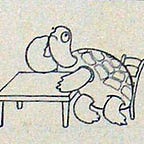203. Today in 1920s Turkey: 21 August 1922 (A Mustache as Collateral)
Comments:
The most striking aspect of the present cartoon is its unique and elevated style. Its imagery consists of two seated men conversing. The forms of the figures are strangely angular with each of the two men sporting slightly disproportionate features such as the large pipe-holding hand of the man on the right and the oversized jacket of the man on the right. The two male figures are further fleshed out with hatching, creating a heavily shaded and dramatic effect for the scene. Bold color blocking is used for the background, most of which is in black and evoking perhaps greenery like a tree line. Finally, an art nouveau-style undulating band frames the entire scene, which is otherwise unremarkable in its figural content.
The second most striking aspect of this cartoon is the contradiction between its aesthetic appeal and the story it conveys. The ornamental frame and chiaroscuro treatment of the figures may prime a viewer to assume the nature of the conversation between the two men to hold a degree of gravity, seriousness, or significance. But rather, as the text below it indicates, the matter is far from elevated or solemn.
Türkçe
— Sana olan vademi ifa edemezsem bıyıklarımı keserim!..
— İyi ama o dediğin şimdi moda…
(Musavviri: Selahattin)
English
— If I can’t repay what I owe you, I will cut my mustache!..
— Alright, but isn’t that already the fashion…
(Its artist: Selahattin)
(Comments continued)
The anecdote and its punchline are not terribly witty, but when contrasted with the dark, chiaroscuro style of the cartoon and read alongside the facial expressions of the two men, new levels of amusement and appreciation for the whole composition are possible.
Finally, the third and last striking aspect about this cartoon is its artist. Thankfully, this piece comes equipped with a clear and printed name for the artist, Selahattin. It also bears his far less legible signature located at the bottom, betwixt the two men. Signed cartoons that also print the name of the artist are very useful in creating a reference base for unknown or lesser-known artists. In fact, our present artist is one such mysterious character, as no other artist that I am aware of has this signature and name. Knowing what Selahattin’s signature looks like, however, can help in identifying more of his oeuvre from this period.
